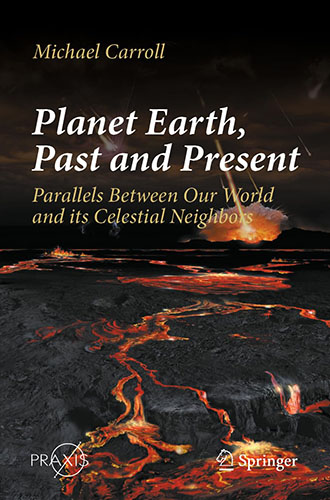Category: Nonfiction
Reviewed by: John J. Vester
Title: Planet Earth, Past and Present: Parallels Between Our World and its Celestial Neighbors
Author: Michael Carroll
Format: Hardcover/Kindle
Pages: 454
Publisher: Springer Praxis
Date: October 2023
Retail Price: $37.99/$19.24
ISBN: 978-3031413599
Find this book
It’s said that you can’t tell a book by its cover. Sometimes that goes for the title too. Planet Earth, Past and Present is about much, much more than our home world. Only the subtitle hints at the richness within: Parallels Between Our World and its Celestial Neighbors.
Written and illustrated by Michael Carroll, a prolific and well respected space artist, this book is a tour de force and a massive source of information about Earth, the rocky planets and the moons of the gas and ice giants. But beyond that, it is an informed consideration of the potential for human settlement on those places, as well as on those tantalizing though unattainable exoplanets.
It’s all told in the accessible prose style Carroll has honed in almost a dozen previous non-fiction books. Enhanced by great photos from multiple space probes and supplemented by beautiful images created by Carroll, this volume has an encyclopedic as well as a coffee table book feel to it.
The author delves deeply into his subjects, beginning at the very beginning: star and planetary disc formation. An analogy is discussed with the so-called “Goldilocks zone” on a galactic scale. It suggests that life is more likely to survive in the more sparsely populated regions of the galaxy, well away from novas and other violent stellar events. Earth’s star is located in the quiet area between the Milky Way’s Perseus arm and the Orion spur.
The many kinds of stars are listed and explained. The effect of the various star types on the habitability of orbiting planets is examined. Earth appears in most chapters as counterpoint to the challenges of life elsewhere. Not that Earth was always a cake walk for life. Here and in Chapter 6 the growing pains of Earth are detailed: The Late Heavy Bombardment, creation of our Moon, the Great Oxygenation Event, snowball Earth, plate tectonics, the dinosaur killer impact, etc.
The book begins with a chapter about the asteroids. Then follow detailed studies of Mercury, Venus, Mars, Titan, and exoplanets. Bolstered by quotes from scientists active in each area, Carroll brings the latest, expert insights to bear on his narrative.
A great many curious and mysterious geological features on other planets and moons are shown and pondered. Scarps, wrinkle ridges, coronae, arachnoids, ticks, Martian spiders, dunes, craters and lava tubes make it clear that today, thanks to planetary space probes, planetology is an endlessly fascinating discipline.
The origin of life is contemplated, with thorough explanations of early theories and their development. The many mass extinction events through the eons are put into context. The resilience of life is encouraging as mankind may have to survive a potential extinction event well before the Earth’s ultimate destruction through the Sun’s expansion.
The mammoth task of terraforming is also treated, visualized through Carroll’s exquisite paintings. If mankind is truly to become interplanetary, Planet Earth, Past and Present should become required reading, or at the very least close at hand as reference and just plain good reading. Especially Chapter 7, “Surrogate Earths: making homes away from home,” which tackles many of the ways humans can live in space, and how we can get there.
Again contrary to what the title implies, the book concludes with a consideration of Earth’s future, along with that of its siblings. It’s a reminder that the colonizing of space will mean, at least, the very, very long term survival of mankind.
Finally, twelve appendices compile and organize the basic facts presented about Earth, its neighbors, stars, continents, space probes, and more. They boil it all down into tables that make for quick reference and easy digestion and comprehension.
Planet Earth, Past and Present should be our indispensible guide book as we venture off planet. As usual for the publisher, Springer Praxis, the book is available for download, or, for a hefty sum, as print on demand. You’ll want to invest in the tangible book, though, and spend quality time with this beautiful, informative jaunt through the final frontier.
© 2024 John J. Vester



















